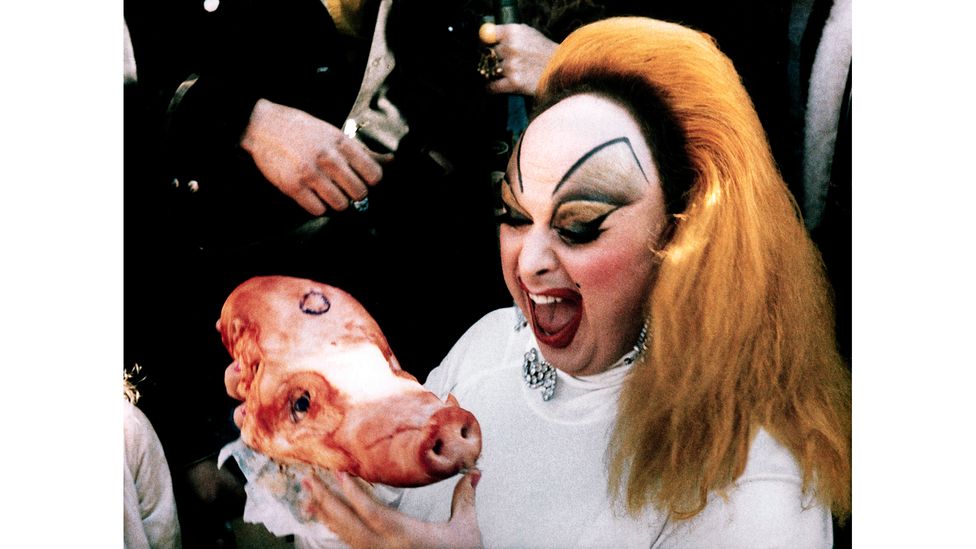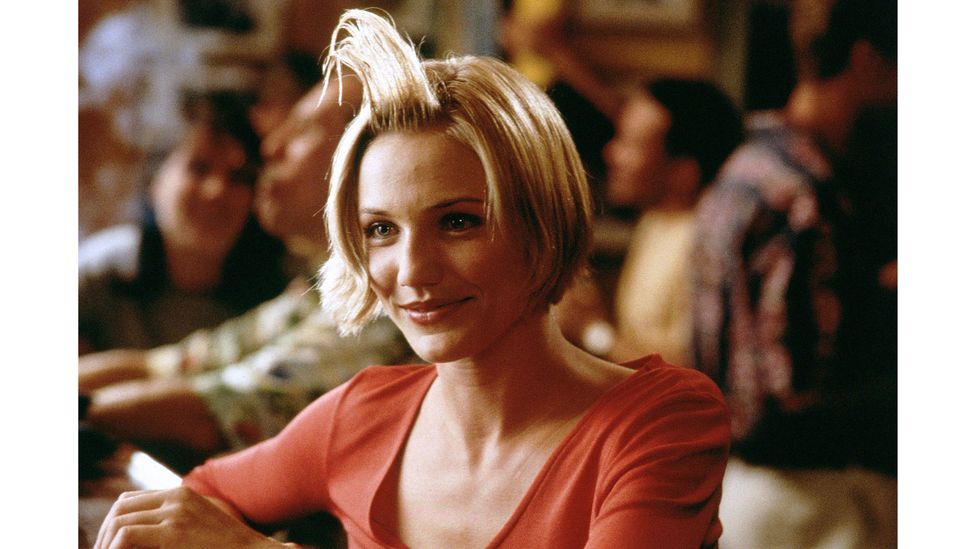Ruben Östlund's Triangle of Sadness won the Palme d'Or at this year's Cannes film festival – and if there was a prize for Best Vomiting Scene, it would have won that, too. The first half of the film is set aboard a luxury cruise liner, where the super-rich are served course upon course of glutinous food. It looks nauseating even when the sailing is smooth, but when a storm tips the liner from side to side, the inevitable happens. And it keeps on happening.
Warning: this article contains offensive language
More like this:
– Triangle of Sadness review
– How Pink Flamingos became a cult hit
– 11 of the best films to watch in October
"If it's going to be done, it's much better if I push it further than the audience expects me to," Östlund told an interviewer from Filmmaker magazine. "I think in the script it says an instruction: 'This scene will go on so long that the audience will start to think: please save these passengers from this suffering'."

Set on a luxury cruise liner, Triangle of Sadness uses gross-out scenes of vomiting and more to satirise social conventions and overconsumption (Credit: Alamy)
In short, Triangle of Sadness is a gross-out movie. It belongs to that much-maligned group of films that dwell on the icky bodily functions which we prefer to keep behind closed doors. They're films in which those bodily functions are especially noisy, protracted and embarrassing for the poor characters in question. And they prompt a unique response in viewers. Geoff King, the author of the BFI Guide to Film Comedy, as well as The Cinema of Discomfort: Disquieting, Awkward and Uncomfortable Experiences in Contemporary Art and Indie Films, puts it like this: "In full-on disgust, the viewer might feel genuinely repelled by the material, but in the comedy form what’s sought is a combination of repulsion and the pleasure of witnessing certain forms of transgressive behaviour. There’s a particular kind of pleasure, I think, that can lie in the balance between the two, a kind of ecstasy of simultaneous horror and delight."
Maybe the Cannes Film Festival has a weakness for that kind of pleasure. In 1983, the festival's second prize, the Grand Prix, went to Monty Python's The Meaning of Life, in which Terry Jones's mountainous Mr Creosote chunders throughout his meal in a French restaurant, and John Cleese's white-tied waiter persuades him to eat the "wafer-thin mint" that causes him to explode in a shower of entrails. But this film and Triangle of Sadness are the exceptions. Usually, gross-out movies don’t win prestigious awards. Whether Finch (Eddie Kaye Thomas) is beset by high-volume diarrhoea in the girls' toilets in American Pie, or Brundle (Jeff Goldblum) is dissolving his food with the pale green goo that dribbles from his mouth in The Fly, films that make a point of revolting us are either comedies or horror movies, both genres which awards voters often dismiss. But that's their loss. Yes, gross-out scenes can be crude and vulgar, but it's still shocking to witness not-quite-solid stuff pouring out of one end of the human body or the other, so these films are, even now, as bold and radical as any avant-garde drama. "We have big taboos about shit and vomit and semen and urine," King tells BBC Culture, "so there's a subversive power in highlighting them and escaping that normal repression."
Another authority on the subject is Professor William Paul, who explores "the aesthetics of grossness" in his book Laughing Screaming: Modern Hollywood Horror and Comedy. He points out that rude, body-related jokes go back to the beginnings of staged comedy – the Greek playwright Aristophanes being one leading proponent circa 400 BC. "He can get pretty gross at times," says Paul. "Lysistrata has men running around with giant erections." Fast-forward to cinema, and gross-out comedy was there from the start. "Charlie Chaplin was criticised at the time for the grossness of his humour," says Paul, "the physicality, the attention to the body – but part of his greatness is that he does this sort of comedy. At the end of City Lights, the Tramp is teased by two paperboys who notice that there’s some cloth sticking out of a hole in the seat of his trousers. To reassert his dignity, he takes out the cloth and wipes his face with it. You can’t get any more gross than that."
A watershed moment
Or maybe you can – but not until the late 1960s, when gross-out comedy and horror as we know them splattered all over our screens. The pivotal year, says Paul, was 1968, when "there were changes all through the western world in terms of attitudes towards drugs and sexual mores". The insides of the human body were a hot topic, too. Debates about legalised abortion were intensifying, and Christiaan Barnard carried out the first successful human-to-human heart transplant in December 1967.
In the arts world, 1968 was the year when Mikhail Bakhtin's Rabelais And His World was published in English: this major study of Rabelais, the French 16th-Century monk and author, set out his themes of the "grotesque body", ie the parts associated with degradation, and the "carnival", ie, a space where society’s rules and hierarchies are temporarily overturned.
In film, 1968 was the year when George A Romero's Night of the Living Dead shambled into cinemas. It was also the year when Hollywood finally abandoned the restrictive Motion Picture Production Code, or Hays Code, which studios had followed since 1934, and replaced it with today's voluntary rating system.

John Waters' Pink Flamingos – and his star Divine – raised the bar for gross-out sequences (Credit: Alamy)
The next decade overflowed with scenes that still trigger a gag reflex to this day. The grossest of gross-out sequences is the finale of John Waters's Pink Flamingos (1972), in which Divine picks up a dog turd from a Baltimore pavement and pops it in his mouth. On a slightly more acceptable note, Mel Brooks serves up the ultimate flatulence scene in Blazing Saddles (1974). In horror, the possessed Regan (Linda Blair) throws up in the face of Father Damien (Jason Miller) in The Exorcist (1973), Sissy Spacek's psychokinetic teen is drenched in pigs' blood at the school prom in Carrie (1976), and a slimy baby monster bursts out of Kane (John Hurt) in Alien (1979).
In some international art-house cases, as in Triangle of Sadness, gross-out scenes were used to comment on social conventions and satirise over-consumption. In Marco Ferreri's orgiastic extravaganza, La Grande Bouffe (1973), four friends endeavour to keep stuffing their faces until it kills them. In Luis Buñuel's surreal The Phantom of Liberty (1974), the characters sit on toilets together in what looks like a dining room, but eat in private while locked away in a small cubicle.
Back in Hollywood, gross-out films were defined by their "gleeful uninhibitedness", says Paul. They offered "a real sense of exhilaration, not without its disturbing quality, in testing how far they could go and how much they could show without making us turn away". The most influential example is National Lampoon's Animal House (1978), in which John Belushi's Bluto starts a food fight by spitting partially chewed mashed potato over his fellow students. John Landis's smash-hit college romp set a trend for what Paul dubs "Animal Comedy", in which sex, rather than romance, is the characters' top priority.
Most of these comedies, from Porkies (1981) to American Pie (1999) and beyond, involve groups of male teenagers, for obvious reasons. These hormone-addled youths are appalled and fascinated by their own rapidly mutating physiques – and by the physiques of their female contemporaries. Bodily fluids are practically oozing out of them. Fear of humiliation is a constant. If you're a teenage boy, you're more or less living in a gross-out comedy, whether you like it or not, so it can be comforting to see your traumas reflected on the silver screen. "American Pie is all about reminding us what the teenage body does," says Glyn White, the author of Laughing Matters: Understanding Comedy in Film, Television and Radio, "how it changes, what its needs are – and how everything has to bend towards it." Besides, adds Paul, "teenagers don't have fully developed adult brains, so we can enjoy seeing them doing things that we're smart enough not to try".
In the 1990s, a new kind of gross-out comedy emerged. First there was the Farrelly brothers' Dumb and Dumber (1994), in which Harry (Jeff Daniels), dosed up on laxatives, makes an emergency dash to a toilet that turns out to be broken. Then came the Farrellys' There's Something about Mary (1998), in which Mary (Cameron Diaz) mistakes Ted's (Ben Stiller) dripping semen for hair gel. "What changed was the extent to which the gross-out was grafted onto romantic comedy," says Paul. "It had been done before: really horrible things happen to Dudley Moore's body in 10 [Blake Edwards' 1979 hit]. But there were still conventions that separated gross physical slapstick comedy from romantic comedy, and those collapsed in the 1990s."
The Farrellys' films, along with American Pie and its many sequels and imitators, were hits because of the sweetness that went with the grossness. "There's Something About Mary keeps the audience on board with an underlying conventional romance of boy-loses-girl and boy-gets-girl," says White. "It has Cameron Diaz with semen in her hair, but people remember the sweetness. It's all about knowing where the line between shocking and funny is, and for a little while, the Farrelly brothers knew."

There's Something about Mary managed to combine romantic and gross-out comedy in a way that felt novel at the time (Credit: Alamy)
Since then, the Farrellys' style of rom-com has fallen out of fashion, but gross-out has exploded, Mr Creosote-like, in directions that would have been unimaginable even in the 1970s – unless it was John Waters doing the imagining. Team America: World Police (2004) gave us puking puppets. Borat (2006) and Jackass: The Movie (2002) brought scatology into the real world with a daring not seen since Pink Flamingos; look up the "Poo Cocktail Supreme" sketch in Jackass 3D (2010) if you don’t believe me.
Gross-out horror movies have also gone to almost unbelievable extremes. While Jim (Jason Biggs) was putting certain body parts in unorthodox places in the American Pie series, other body parts were being lopped off in Takashi Miike's Audition (1999) and Ichi the Killer (2001) and in Eli Roth's Cabin Fever (2002) and Hostel (2005), as well as in Saw (2004) and numerous other so-called "torture porn" films. Then there was Park Chan-wook's Oldboy (2003), in which Choi Min-sik eats a live octopus. And yes, that's an actual live octopus. And yes, Choi actually eats it.
As repulsive as these horror films can be, gross-out comedy usually has an inclusivity to it that warms the heart, even while it turns the stomach. The theme behind every candid depiction of an out-of-control body is our common humanity – the often-overlooked fact that we’re not gleaming robots or clouds of philosophical thought, but fleshy, fallible creatures prone to all manner of squelches and stinks on a daily basis. To gasp and wince during a gross-out sequence is to have a giddy moment of connection with the people on the screen and in the cinema. All the barriers between us are dissolved by those sloshing bodily fluids. True, maybe we haven't all been sick on someone's head, used a washbasin as a toilet, or defecated in the street while wearing a designer wedding dress, as Melissa McCarthy and friends do in Bridesmaids (2011). But we all know that something like that could happen to any of us. Gross-out is a great leveller. "A lot of comedy depends on the idea of superiority, and laughing at someone who’s inferior to you," says King. "But in gross-out comedy, the characters are going through something that you could be going through yourself." The next time you're on a cruise liner, bear that in mind.
Triangle of Sadness is out in US cinemas now and will open in UK cinemas on 28 October.
Love film and TV? Join BBC Culture Film and TV Club on Facebook, a community for cinephiles all over the world.
If you would like to comment on this story or anything else you have seen on BBC Culture, head over to our Facebook page or message us on Twitter.
And if you liked this story, sign up for the weekly bbc.com features newsletter, called The Essential List. A handpicked selection of stories from BBC Future, Culture, Worklife and Travel, delivered to your inbox every Friday
https://ift.tt/Np1aoqn
Film
Bagikan Berita Ini














0 Response to "Triangle of Sadness and the grossest films ever made - BBC"
Post a Comment